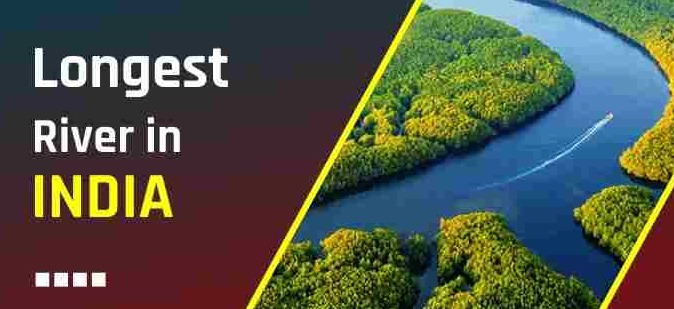Top 10 Longest Rivers in India: India is known as the “land of rivers” due to the abundance of rivers that flow throughout the country. India is the land of rivers, and these mighty waterways play a significant role in the country’s economic development. Himalayan Rivers (rivers that originate in the Himalayas) and Peninsular Rivers are the two distinct types of rivers in India ( rivers that originate in the Peninsula ). Himalayan rivers are perennial, whereas Peninsular rivers are fed by precipitation. The top 10 longest rivers in India will be discussed in this article.

Longest River in India 2023
Here is a curated list of the longest rivers in India that one must visit to experience the true beauty of these bodies of water. India’s rivers are divided into two categories based on their source: Himalayan rivers and peninsular rivers. The Indian River system is essentially divided into two sections: Himalayan rivers and peninsular rivers. The majority of India’s rivers flow east and empty into the Bay of Bengal. Only three rivers in India flow from the east to the west. Rivers like Indus, Ganga, Yamuna, Brahmaputra are Himalayan rivers and Mahanadi, Godavari, Krishna and Kaveri are peninsular rivers.
List of top 10 Largest Rivers in India
Ganges River: 2525 KM
Ganga, also known in India as Ganga Mata, is the holiest river for Hindus and is revered as Goddess Ganga. Sadly, it is one of the world’s most polluted rivers. The Ganges, which begins in the Himalayas at the Gangotri Glacier in Uttarakhand and empties into the Bay of Bengal, flows through one-fourth of India’s territory and supports hundreds of millions of people in its basin. The Ganges is India’s longest river and the world’s third-largest river. This reservoir encompasses the states of Uttarakhand, Uttar Pradesh, Bihar, and West Bengal. Bangladesh marks the end of the Ganges’ final reach.
Godavari River: 1464 KM
After the Ganges, the Godavari is the second-longest river in India. It has been revered in Hindu scriptures for numerous centuries and has fostered a rich cultural heritage. Godavari, also known as Dakshina Ganga, is the longest river in South India. The river begins in Trimbakeshwar, Nashik, Maharashtra, flows through Chhattisgarh, Telangana, and Andhra Pradesh, and empties into the Bay of Bengal after traveling more than 1,450 kilometers.
Krishna River: 1400 KM
The Krishna River (also known as Krishnan) begins near Mahabaleshwar in Maharashtra in the Western Ghats. It is one of the most significant peninsular rivers in India, flowing through Maharashtra, Karnataka, and Telangana before entering the Bay of Bengal in Andhra Pradesh.
Yamuna River: 1376 KM
The Yamuna River is the Ganges’ longest tributary. The Yamuna originates from Yamunotri Glacier at Bandarpoonch peak in Uttarkashi, Uttarakhand. It traverses 1,376 kilometers through the states of Uttarakhand, Delhi, Himachal Pradesh, Haryana, and Uttar Pradesh.
Narmada: 1312 KM
The Narmada River (also known as Rewa) is the largest river in peninsular India that flows westward. The Narmada begins in Madhya Pradesh’s Amarkantak mountain range. It is one of India’s seven sacred rivers and is mentioned in numerous ancient Hindu texts. After a distance of over 1300 kilometers, the river empties into the Arabian Sea.
Indus River: 1,114 kilometers
The Indus River is the cradle of the ancient Indus Valley Civilization and is of immense historical importance. Consideration is also given to naming our nation after this great river. From Lake Manasarovar, the Indus River flows through Ladakh, Gilgit, and Baldistan. Afterward, the river enters Pakistan. The Indus Water Treaty between India and Pakistan allows India to use 20% of the Indus River’s total water flow. Kabul (river), Jhelum, Chenab, Ravi, Beas, and Sutlej River are among the major tributaries of the Indus River. The total length of the river Indus is 3,180 kilometers. The distance within India, however, is only 1,114 kilometers.
Brahmaputra: 916 KM
One of India’s major rivers, the Brahmaputra, originates from the Angasi Glacier in the Himalayas in Tibet. There, the river is known as the Yarlung Tsangpo. The river flows into India via Arunachal Pradesh. The river then enters Bangladesh through Assam. The Brahmaputra delta is home to 130 million people, including 600,000 who live on the river’s islands, and the river is commonly referred to as “Assam’s lifeline.”
Mahanadi River: 890 KM
Mahanadi is derived from the Sanskrit words maha (“great”) and Nadi (“river”), which together mean “great river.” The river originates in the Sihawa mountains of Chhattisgarh and flows predominantly through Odisha. The Mahanadi River collects more sediment than any other Indian subcontinent river. The largest earthen dam in the world has been constructed on the Mahanadi River in Odisha, close to the city of Sambalpur. Behind the Hirakud Dam is the 55-kilometer-long Hirakud Reservoir, one of Asia’s longest artificial lakes.
Kaveri: 800 KM
Kaveri or Kaveri is Tamil Nadu’s largest river. Talakaveri in the Kodagu district of Karnataka is where the Kaveri rises from the Western Ghats foothills. The river flows southeast through the states of Karnataka and Tamil Nadu and empties into the Bay of Bengal in Tamil Nadu. The Kaveri river forms two islands at Srirangapatna and Shivanasamudra during its journey from the Kodagu hills to the Deccan plateau. The Kaveri River is often referred to as the Ganga of the South.
Tapti River: 724 KM
Tapti river Tapti flows from peninsular India through Madhya Pradesh, Maharashtra, and Gujarat before entering the Arabian Sea. It is one of only three peninsular rivers that flow from east to west in India. The Tapti River nourishes and sustains the flora and fauna of the Melghat forest, which is famous for its abundance of flora and fauna.